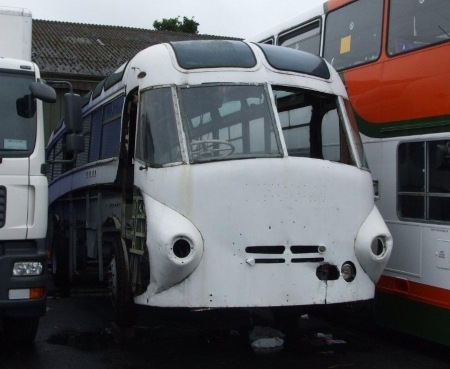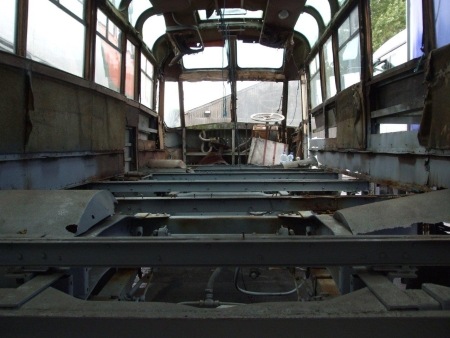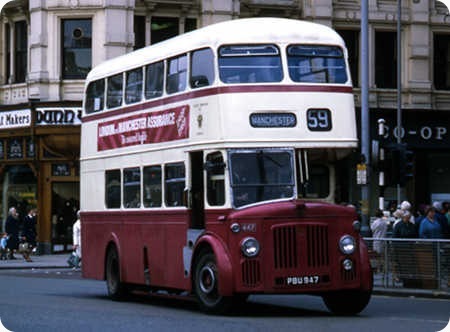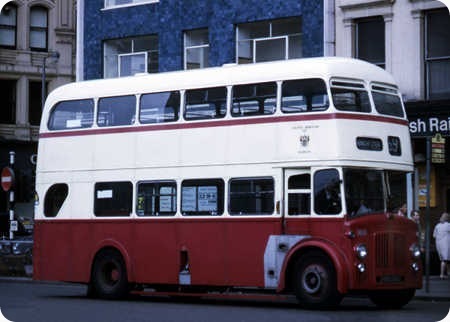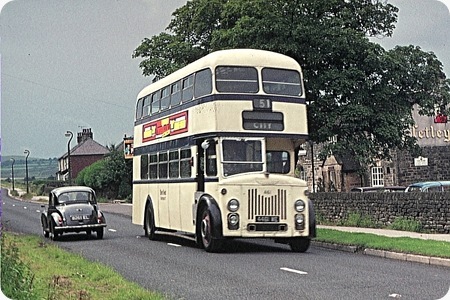Hebble – AEC Regent III – AJX 245 – 30
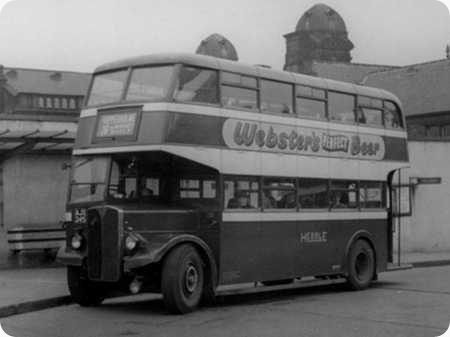
Photograph by ‘unknown’ if you took this photo please go to the copyright page.
Hebble Motor Services
1948
AEC Regent III 9612E
Roe L27/26R
I recently came across this photograph. I know very little about its history with Hebble, but it is familiar to me – after sale by Hebble, this and an identical vehicle AJX 281 were both acquired by an operator very local to me at the time, Makemson of Bulwell, Nottingham.
They arrived in January 1961, and ran for a while as acquired; the Makemson livery was dark red and cream, so the Hebble colours fitted in well. They replaced an ex Ribble Leyland bodied TD7, RN 8990 and
CRR 92, a 1936 AEC Regent new to West Bridgford UDC. Neither of the ex Hebble Regents lasted long with Makemson, both were withdrawn in the second half of 1962, and were sold for scrap to a local dealer/showman.
Hopefully the Yorkshire based correspondents will know its earlier history, and the location of the photograph.
Photograph and Copy contributed by Bob Gell
25/03/12 – 11:22
This photo just got me in the nostalgia department Bob!
One of Hebble`s Regent 111s, in Chester Street Bus Station, Bradford, probably some time after 1956.
It is the starting point (or was!) of the 19 service from Bradford to Bingley, via Allerton, Wilsden and Harden, a service I rode on regularly.
The route was regularly served by the Weymann bodied Regal 11s of 1946, until their withdrawal c.1956.
The 19 service followed BCPT Trolleybus 31 route as far as Allerton, and provided an alternative for us trolleybus enthusiasts to sample, as did the West Yorkshire route to Denholm and Keighley, which followed a similar route out of the City as far as Four Lane Ends, and thence with the 7 trolleys to Thornton and beyond.
Many a time have I ridden on this bus and her sisters when visiting a well known hostelry at Wilsden, known a " t`Ling Bob".
John Whitaker
25/03/12 – 12:05
Nostalgia here too John – for I used to greatly admire these lovely vehicles as they occupied the stand in King Street, Leeds next to our Samuel Ledgard terminus for Horsforth, Guiseley and Ilkley. The Hebble vehicles left at 20 and 50 minutes past the hour on services 15 and 28 to Rochdale or Burnley. Can anyone today imagine the wonderful scene in King Street each weekday between 1715 and 1730 – passengers then were plentiful. Two Hebble buses (one duplicate) left at 1720, leaving room on the stand for no less than four Samuel Ledgard machines for the 1730 to Ilkley thus – 1727 to Rawdon, 1728 to Guiseley, 1729 to Ilkley, 1730 to Ilkley. Those were the days and no mistake !!
Chris Youhill
26/03/12 – 07:48
I imagine Chris that the current 508 route is the "fag end" of Hebble’s 15 and 28 services. The 508 takes over an hour to get to Halifax; do you have any old timetables which might show how long the 15 and 28 took to get to their destinations in Lancashire? And did the Burnley route go over the top via Heptonstall and the Sportsman Inn or did it go via Todmorden and Cornholme?
Dave Towers
26/03/12 – 11:02
From my June 1965 Hebble Timetable.
Route 15 left Leeds 17:20 and via Halifax 18:18 – Heptonstall Slack 18:56 – Sportsman Inn 19:15 and arriving Burley at 19:38 – 2hrs 18min later.
Route 18 Left Leeds 17:50 and via Halifax 18:45 – Ripponden 19:03 and arriving Rochdale at 19:41 – 1hr 51min later.
Peter
26/03/12 – 13:15
Yes Dave, the 508 which was instituted by the PTE, was indeed the Halifax – Leeds section (or fag end) of the Hebble services. I say "was" because in recent times service revisions appear to be endless, and the 508 has been re-routed in Leeds away from the City end of the A647 Armley Road. It now uses the A65 as far as Kirkstall and then goes via the old Leeds and Bradford Road and Farsley before rejoining the A647 at Stanningley, then as before.
Thanks to Peter for the Hebble 15/28 details which I did not know – I do though just recall from King Street days that one of the displays showed intermediate points as "Dudley Hill, Halifax, Littleborough – I think !!
Chris Youhill
26/03/12 – 16:58
Thanks for the interesting replies, Peter and Chris. The 508 was re-routed when the 15 Bradford to Farsley service was withdrawn a couple of years back. It provided an extra service to Farsley (though not from Bradford centre) and the 72 frequency was increased to compensate for less buses down the A 647.
A 508 leaving Leeds now at 17:35 is given 1hr 29 mins to reach Halifax. A 592 leaving Halifax is given 1hr 25 minutes to reach Burnley, so add them together and you’re just short of 3 hours – such is progress! I suppose back in 1965, whilst the vehicle would be slower, there wouldn’t be as much traffic around and if double deckers were used, the service would be crew operated. It’s not a direct comparison though as the routes don’t totally match each other.
Dave
27/03/12 – 07:19
I travelled regularly on the Burnley/Rochdale to Halifax sections of these routes back in 1965-70 and don’t remember seeing double-deckers in use on them anywhere west of Hebden Bridge. Usually it was Weymann Hermes/BET style saloons, although on one occasion I managed to talk myself on board a Hebble Bellhouse Hartwell Landmaster serving as a duplicate – in theory only for passengers connecting to Yelloway’s overnight departure to Torquay. The Landmaster then went "on hire" to Yelloway. Am I right in thinking that one of these wonderful coaches survives?
Neville Mercer
27/03/12 – 07:19
This photo and the comments bring back happy memories from my childhood. One of the joys of travelling by Hebble on the 15 or 28 from Leeds was the (usually) non-stop thrash to Stanningley Bottom. This was the result of the then very common revenue protection arrangements enforced by Leeds City Transport within their boundaries.
To a twelve year-old lad, the pleasure and novelty of overtaking LCT buses on Armley and Stanningley Roads was always appreciated and a fitting end to a day’s train spotting, even though Hebble’s first permitted stop was well beyond our usual destination. In keeping with our childish mentality were our giggles when being asked by what was probably the first Asian conductor I’d encountered, "Are you sure you want this bus – the first stop is Stanningley Bottoms!".
Paul Haywood
27/03/12 – 07:21
These services have an interesting history. Road service licensing meant that, as Todmorden already had services in the valley, Hebble had to be content with getting to Burnley through Heptonstall. This was a route not suitable for double-deckers and in some winters not suitable for buses at all. They provided an hourly service though for the sheep to watch – there was little in the way of traffic on this section.
The Rochdale service had a variety of operators including the LMS Railway from Rochdale to Leeds. That was hourly, again with single-deckers, in this case due to low bridge in Littleborough, although the Rochdale to Halifax section was half-hourly on Saturdays. It also included a through journey to Llandudno on summer Saturdays, just slightly west of Rochdale.
When Calderdale JOC was formed Halifax, Todmorden and Hebble became all part of the same organisation and a rationalisation of services ensued. The service to Burnley via Heptonstall became two journeys on a Saturday and through traffic was dealt with by linking the Halifax to Hebden Bridge and Todmorden to Burnley services, supplemented with an express Leeds-Burnley service, the 8. The express service was not successful and was truncated to a Leeds to Halifax service, the 8 which became the 508 under the PTE numbering scheme. Up until 1976/7 it was worked exclusively from Halifax but then operation was shared with Leeds, just in time to allow some of the last surviving buses in Leeds livery to work it – I have a picture of Jumbo 491 in Halifax on it.
The Rochdale service became really exciting in Halifax ownership. The existing 28 ran every two hours and alternated with a new 27, which turned off at Triangle and passed through Soyland and Mill Bank before rejoining the 28 near Baitings reservoir. The 27 was a lovely run along hilly country lanes but made exciting by the fact that for all the detour, it didn’t have any more running time. The Leopards used on it gave a very spirited performance. I used to love riding on it and more than once had Tony Blackman at the wheel, which was even better.
After deregulation the Rochdale services were operated by Yelloway and saw such vehicles as Plaxton-bodied Reliance coaches and National 2s.
I used to use the 508 when I was at Leeds University to get back from Halifax (and beyond) after a pub crawl as you could get back later from Halifax than most other places.
David Beilby
27/03/12 – 15:50
David, your comment reminds me of the time when Leeds began to operate the 508 service out of Bramley depot. Its difficult now to imagine how very "parochial" the Leeds operation in general was in those days – even those drivers aware of the long distance journey to Bradford were looked on by the rest as brave explorers. When the Halifax participation began only a limited number of drivers were familiarised and they became celebrities almost overnight. I was once "showing up" (spare) in Leeds Bus station with an AEC Swift and a conductor when a harassed inspector enquired of the several crews if anyone knew the way to Bradford as there was a serious hiatus in the frequent service – I volunteered immediately with glee, and was looked on by the others as a "double agent" who’d let the side down and broken up the card school. I enjoyed the trip immensely, full load all the way there and back, and managed to handle all the usual passenger jibes "Thought you’d gone on strike" etc – the young conductor was not amused at all – no stamina some of them you know !!
Chris Youhill
27/03/12 – 15:51
I once caught the Rochdale – Leeds service in Calderdale days. The steed was a Weymann bodied Leopard which gave a good account of itself .However it was a chilly spring evening and the rubber edging on the door was somewhat frayed and the ensuing draft assumed Antarctic proportions on the tops . Like many Calderdale buses the Leopard was fitted with the unusual and eccentric method of change giving whereby the coins rattled down a chute to the right of the passenger The journey cost me 40p at the time what a bargain! Incidentally First ran a short lived direct peak hour Leeds – Halifax direct service numbered X8 which has now ceased.
The Heeble service from Bradford via Queensbury to Halifax was another epic with astounding views into the Calder Valley as you headed into Halifax
Chris Hough
28/03/12 – 08:44
I’ve been wondering exactly the same as Neville Mercer about the Hebble Royal Tiger/Bellhouse Hartwell. It was ECP 500 and apparently someone made an appeal to Dewsbury Bus Museum to see if it could be saved but that was well over a year ago and as nothing has been heard since, I fear it has been lost. A very sad event if so because I thought they were wonderful machines, they exuded fabulous Fifties flamboyance!
Chris Barker
28/03/12 – 08:44
When Calderdale took over the Leeds services they tended to use dual purpose saloons interspersed with bus Leopards and front entrance Titans and Regent V. However the depot must have been short of motive power one afternoon as the 4PM departure from Leeds to Burnley was an ex Todmorden all Leyland PD2/12! Despite its age around 20 it stormed up Stanningly road leaving LCT vehicles trailing in its wake! It was still carrying Todmorden livery which must have confused passengers no end
Chris Hough
28/03/12 – 11:32
There is a good shot of ECP 500 in Malcolm Keeley’s Buses in Camera ‘Mercian and Welsh’
Roger Broughton
28/03/12 – 11:33
I agree with Chris Barker that it would be a tragedy if the Landmaster has been scrapped. These were never that common – the only other one I ever managed to ride on was an AEC Regal IV belonging to Meredith & Jesson of Cefn Mawr. M&J frequently used their example on their stage service to Wrexham! I fear that if the Hebble machine has indeed gone, then the glorious BH Landmaster is now extinct. Where on Earth are people’s priorities when there are hundreds of Routemasters still in preservation? Thank heaven for far-sighted preservationists such as Roger Burdett and the Ementons who bring a bit of welcome variety to the preservation scene.
Neville Mercer
28/03/12 – 11:37
Gentlemen – thank you for filling in the information on this Regent’s Hebble days, I’m pleased you found the photo of interest.
One question though – why is the bus parked with its offside nearest the platform/bay/stand – was it normal practice, or a one off?
Also there has been mention of the Hebble Royal Tiger ECP 500, below are a couple of shots as it was when I photographed it in Lancashire in August 2008.
Bob Gell
28/03/12 – 18:25
Chester Street bus station in Bradford was basically two rudimentary laybys with Chester Street going through the middle West Yorkshire used the layby opposite the Hebble stands which was also home to Yorkshire Woollen and Yorkshire Traction services. As well as the aforementioned laybys the actual street was also utilised. The whole set up being very spartan with little in the way of passenger facilities
Chris Hough
28/03/12 – 18:29
…..and there was also the Sheffield United Tours pair of 1955 Reliances. They seemed to be an extra order and the bodies were apparently cancelled by Blue Cars and originally intended for Leyland chassis. Blue Cars already had examples.
David Oldfield
28/03/12 – 18:30
Apparently the Landmaster was due to be scrapped, but at the eleventh hour it was reprieved when Ensign agreed to take it on. Having seen some of the restoration jobs they have undertaken, this was a great relief, but I am told that even they decided that it was beyond redemption, and that it may well have been scrapped by now. I hope not, as it would be a tragic loss.
John Stringer
28/03/12 – 18:31
I have a feeling that I read somewhere, not so long ago, that Ensign had been approached to save ECP500, but had declined because of its stripped out condition and its frailty, making it too tricky to tow.
Chris Hebbron
28/03/12 – 18:38
To answer Bob Gell’s latest question – Chester Street Bus Station (but not the through road down the middle) operated at this time as “one way” for buses.
Thus they all entered via Little Horton lane and exited via either Great Horton Road or (in the case of buses heading back up Little Horton Lane – The Sheffield 66 joint service and certain Hebble Routes) via a loop on Wilton Street past the morgue and thence back up Little Horton Lane.
The non West Yorkshire side had two stands – on the side pictured there were the Hebble Stands for the 7 & 17 Halifax services, the two Hipperholme (26) routes (where AJX 245 appears to be heading as far as I can tell from the blind), and the Bingley 19 service via Wilsden. Additionally there was the joint Yorkshire Woollen and North Western X12 Manchester service. Any remaining space nearer Little Horton Lane was taken up with spare West Yorkshire vehicles between turns. Interestingly these were parked against the traffic flow – presumably so that they could regain the West Yorkshire half facing in the right direction ready for their next run. Thus all these service buses loaded on the live bus carriageway.
On the other side of this half there were stands for the Sheffield 66, (joint Sheffield’C’ Yorkshire Traction and Yorkshire Woollen.) and also the Samuel Ledgard Leeds via Pudsey Routes. These loaded from the kerb.
On the West Yorkshire half, all routes with the exception of the 67 Keighley/Skipton loaded in the middle of the bus carriageway as they were parked “herringbone” either side of the Green Hut. All passengers for these routes had to cross the bus carriageway to join their buses.
All in all the place was somewhat hazardous for passengers to say the least. I think things were remodelled sometime in the late 60’s. Returning to AJX 245 it was bound for Hipperholme Crossroads via Wibsey. There were two routes 26 and 26a, one branching off just after Stone Chair at Shelf to run through Coley village with other keeping to the main road through Lumbrook. There was a short working for a time to the edge of the then new Bradford Council Buttershaw Estate which displayed Boltby Lane – running I recall at peak hours only. This was discontinued when Bradford Corporation built a trolleybus extension into the heart of the Estate. One other interesting bit of information is that there was a through route to Halifax (29) that ran on this route from Bradford as far as Shelf thence to Halifax – for some reason on Saturdays only. It was termed the “Wibsey Flyer” – its route was marginally shorter than the main routes through Queensbury or Odsal/Shelf and Hebble drivers always liked a challenge.
And finally I used to visit my Sister for lunch once a week – she lived in Allerton on the Hebble Route 19 from Bingley. I always used to catch the Hebble back into Bradford, I reckon it could shave at least 5 minutes off the 31 trolleybus – rarely stopping at all after the Chapel Lane stop in Allerton. As I said the Hebble drivers liked a challenge !
Farmer G
29/03/12 – 08:04
The Samuel Ledgard (formerly B & B TOURS) buses for Harrogate also departed from the "West Yorkshire" side of Chester Street Bus Station. Their route was identical to the WYRCC 53 service except that "the blues" deviated from the main road at the Hare and Hounds and additionally served the full length of Menston Village.
Chris Youhill
29/03/12 – 08:06
What a shame to think that ECP 500 has survived so long only to be lost so recently. Whilst in a poor state it doesn’t look so dreadful compared to some restorations. I managed to find a photograph of it taken in 1976 and better times when it appears to be in fine condition.
Here… //s880.photobucket.com/
Richard Leaman
29/03/12 – 08:07
To sort of illustrate Chris’ memory on this thread (which seems to be unravelling into about three different themes) the attached picture shows the bus he was referring to, which was Calderdale 357. This one lasted quite a while in Todmorden livery and I’m pretty sure was the last to carry it by some margin.
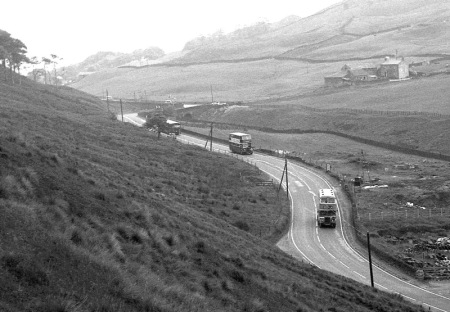
This picture is taken near Cliviger, between Todmorden and Burnley, a location much better known to railway enthusiasts as Copy Pit and a bit of a shrine in the very last days of steam.
What it shows is a Halifax PD2 on the 8 from Burnley to Leeds, with 357 behind on what I recall as a duplicate. Behind that is a Ribble Leopard on an express service to Manchester.
David Beilby
29/03/12 – 17:50
I love your comments, Farmer G, about the speed of the Hebble 19 service! They were flyers alright, especially before the route was double decked. Swirls of dust and dead leaves in their wake!
West Yorkshire, down Thornton Road were just as exciting sometimes, even with 5LWs, but one of the reasons was the longer spacings of bus stops, and the penny surcharge in the City boundary, which got them to Town quicker, but which most thrifty Bradfordians did not experience because of said surcharge.
Mind you, the old "Regen" trolleys could move a bit too! Memories of hurtling down Thornton Road, from Spring Head to Bell Dean come to mind. So much for "silent trolleybuses"! They made more noise than a Hebble and a WY combined!
Happy Days!
John Whitaker
30/03/12 – 07:08
What a superb photo David B! When was it taken, early PTE days perhaps?
Dave Towers
30/03/12 – 08:52
Sorry – I forgot to add a date! It was on 17th June 1972.
David Beilby
17/09/12 – 06:58
I well remember the Hebble service over the tops to Halifax in the 1960s–used to use it on Saturdays to call at the Sportsman for a few jars–great service–do any buses go over the tops these days? Hard for me to check as I left to live in France when I retired.
John Oakes
17/05/13 – 09:09
I was a parcels delivery driver for rail express in the early 1970s I noticed ECP 500 in the yard at Talbot House school in Glossop whilst delivering there. I wrote to the H C V C in the hope that someone could rescue her 40 years on I have just found out that John S Hinchliffe purchased her from the school. Some pictures I have seen show that she scrubbed up well how sad that more recent pictures tell a different story.it would appear that she did not survive
John Kelly
05/04/14 – 07:12
I lived in Northowram and when the Bradford service was routed via Stone Chair and Landemere under Calderdale, we often had to give directions to drivers who previously stopped at the Northowram boundary or at least, only knew the main road between Bradford and Halifax. They would fly down the hill from Stone Chair only to find around a slight bend at the bottom that there were passengers standing in the road (no pavement). The drivers were none too happy in trying to pull up a Fleetline in short order!
John Turnbull
06/04/14 – 08:24
John, I was once involved in a collision on the ‘slight bend’ you mention, which was towards the bottom of Score Hill and just above Landemere Syke.
If they were on time, opposing buses were due to pass one another in Score Hill, so could easily meet on the bend. There was a stone barn belonging to the adjacent farm on downhill side, right on the bend, severely restricting visibility, so one quickly learned to scan the view ahead over the top of the farm from much further back – whilst travelling along Northowram Green (outbound) or from the top of Score Hill (inbound). Though it was not an official instruction, the regular drivers’ convention was for the inbound bus to slow right down or stop half way down the hill until the outbound one had safely negotiated the corner.
One weekday afternoon I was outbound towards Bradford in an ex-Halifax Fleetline. I did the usual scan ahead and could not see a bus descending the hill, so I proceeded and approached the bend with great caution. Unfortunately, whilst I had been passing through the blind section of the dip at Landemere Syke the inbound bus had come over the brow of the hill and was hurtling down it rather too speedily. The weather conditions were dull and drizzly, so the road surface was already wet, but the fact that the farmer from Wall Nook Farm had earlier herded his cows down the road meant that there was a lethal coating of slippery brown stuff too.
As I very slowly rounded the bend I then saw the bus – another of the same type – coming towards me and so stopped immediately. The other driver had only passed out of the driving school a few days before and must have panicked, hitting the brakes hard. It went into a lengthy skid – totally out of control – and as Fleetlines would do in such instances went into a front wheel skid on the bend. I instinctively accelerated to the left to avoid being hit head on, and the bus collided violently with my front offside then bounced off in the other direction and buried itself in the barn wall, virtually destroying it.
Strangely I felt quite calm, and was about to leap out to check if the other driver was injured – fearing the worst. I raised my arm to brush a fragment of something from my hair, and my conductor Ken got into a bit of a state and shouted at me not to move, and not to touch my head – pointing at it anxiously. I looked in the mirror and there was a very large triangular-shaped section of my offside cab window glass stuck into my hair in an upright position – like a kind of glass Mohican ! He’s assumed it must have been buried into my skull, but I just flicked it away without any red stuff gushing out, much to his relief.
Miraculously neither the other driver nor any of our passengers were injured. Police and our inspectors and engineers were soon on the scene, and the other bus had to be extracted and towed away. Our inspector – the late John Davis – having knocked out the remaining broken glass from my side windows and twisted off various bits of metal trim and the odd panel, deemed that my bus was fit to drive, and decided that the other badly shaken driver should drive it back to depot under his supervision, fearing that otherwise they would go home and never want to drive again. That would most certainly not happen nowadays, but fortunately he was right and the driver did carry on and drove for a few more years. The barn was eventually rebuilt, and ever afterwards each time I passed it I could not help being reminded of the incident, and of what might have been.
John Stringer
06/04/14 – 10:44
A very ‘interesting’ tale, in more ways then one, John. The scary thing is seeing things unfold and it was quick-witted of you to get your bus moving so quickly when trouble approached. The amazing thing is that the barn was rebuilt, so perpetuating the very danger that caused the accident!
Chris Hebbron
16/06/15 – 06:41
More on the Hebble Halifax to Burnley route. When I began drinking, the Shoulder of Mutton at Blackshaw Head was a lively place with bands on every Friday and our friends place to be for years. We used to meet in Halifax at the Bulls Head, then catch the 7-30 pm Hebble. It used to "fly" down the Calder Valley and we were usually at the pub soon after 8 pm. Going home was more difficult at the last bus was while the band was still playing as the pub stayed open very late. You had to see if you could cadge a lift off someone or leave early. (Back to Northowram) Happy days!
John Turnbull
02/08/16 – 17:30
Hebble ran several services out of Bradford. Two to Halifax No’s 7 and 17. Huddersfield 64, Bingley 19. One to Duckworth Lane. Hipperholme 2 ways – Lumbrook and Coley alternate. Saturday only 29 to Halifax via Wibsey and the Bolby flyer peak hours to Buttershaw estate. Several Yorkshire Woollen vehicles were housed in Park Rd. The X12 to Manchester ran a YWD vehicle.
Allan Wood
 Vehicle reminder shot for this posting
Vehicle reminder shot for this posting
17/12/18 – 07:21
A few of my own comments. As to Hilditch having Bradford and Leeds put onto destination blinds, Bradford was on many right back to the 1950s. All the Daimler CVG6 class had Bradford on them, although never running past the Queen Victoria at the Borough Boundary. It was to be found on many other vehicles long before Hilditch took over.
When the 7 was diverted to Stone Chair and Northowram Hospital, I lived at Landemere and When Bradford began sharing the route, was called to the bus stop and asked which direction to take the bus. It was common for a while that the driver would shout back and ask passengers the way to go after leaving the main Bradford road.
For quite a long time, vehicle inspectors would board vehicles at Crossfield before allowing passengers on and do a check. One time after looking here and there, he forbade anyone to board and directed it to be parked in Gt.Albion St. (AEC Regent V-Weymann). We then had to wait for one to come down off the parking area to take over.
As all have said, that last period was appalling for Hebble. Goodness knows what the mechanics thought as people must have been pointing fingers.
John Turnbull
Quick links to the - Comments Page - Contact Page - Home Page
